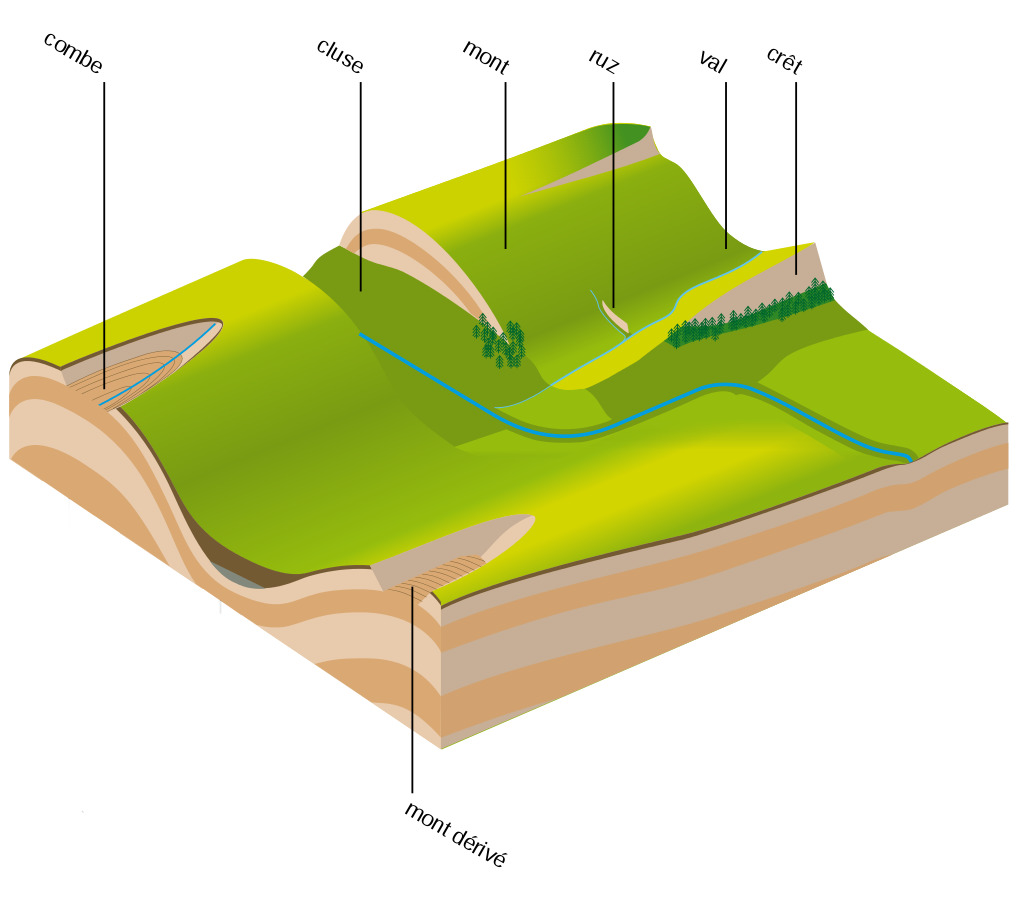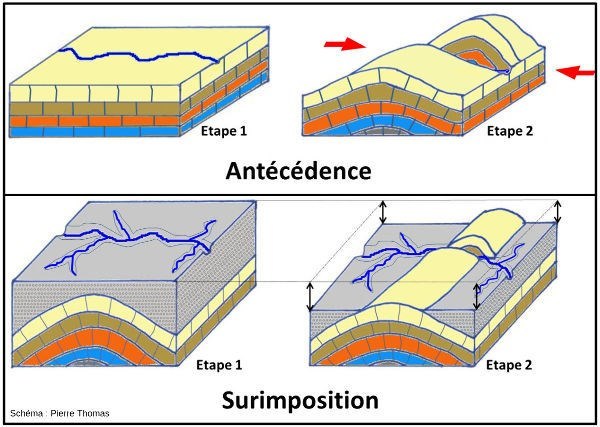La Vée, affluent de la Mayenne, coule du Nord au Sud à travers les terrains paléozoïques du synclinal de Domfront - Bagnoles. Elle franchit la bordure sud de ce synclinal en creusant une cluse en zig-zag dans le Grès armoricain, à la faveur d’un réseau de fractures lié au plissement varisque.
La morphologie de la cluse, vallée étroite aux parois verticales, est bien visible dans le secteur occupé par les Thermes de Bagnoles-de-l’Orne.
The Vée, a tributary of the Mayenne, flows from North to South through the Paleozoic terrains of the Domfront - Bagnoles syncline. It crosses the southern edge of this syncline by digging a zig-zag cluse in the Armorican Sandstone, thanks to a network of fractures linked to the Variscan folding.
The morphology of the cluse, a narrow valley with vertical walls, is clearly visible in the area occupied by the Baths of Bagnoles-de-l'Orne.
Rappel géologique / Geological reminder
Définition et formation d'une cluse
Une cluse ou clue est une vallée creusée perpendiculairement dans une montagne par une rivière. Cela crée une gorge entourée de falaises. Les cluses se forment essentiellement dans les massifs calcaires et sa structure est assez spécifique.
Definition and formation of a cluse
A cluse or clue is a valley dug perpendicularly in a mountain by a river. This creates a gorge surrounded by cliffs. The locks are mainly formed in limestone massifs and its structure is quite specific.


Droits réservés - © 2015 Pierre Thomas
La première situation correspond à ce qu'on appelle l'antécédence, parce que la rivière coulait avant la formation du pli. La rivière coulait sur un terrain plat constitué de couches horizontales. Elle y a creusé une légère vallée. Un plissement a déformé cette série et a engendré un anticlinal qui s'est bombé très progressivement (typiquement avec une vitesse de l'ordre de grandeur du mouvement des plaques, à savoir une vitesse de l'ordre du centimètre/an). La rivière s'est (relativement) enfoncée sur place au niveau de l'anticlinal et y a creusé une cluse.
La deuxième situation est appelée surimposition, parce que des couches (horizontales) peu résistantes se surimposent et recouvrent en discordance un anticlinal préexistant, anticlinal fait de roches résistantes. La rivière creuse une vallée dans la couche discordante peu résistante. Quand le fond de la vallée atteint le sommet de l'ancien anticlinal, elle ne peut plus aller à droite ou à gauche, bloquée qu'elle est dans la rivière qu'elle vient de creuser. Elle ne peut plus que creuser sur place l'anticlinal dans la continuité des vallées amont et aval creusé dans la roche tendre. L'érosion générale érodant beaucoup plus les roches tendres que de les roches dures constituant l'anticlinal, celui-ci se retrouve en relief, relief traversé par une cluse.
The first situation corresponds to what is called antecedence, because the river flowed before the fold formed. The river flowed on flat ground made up of horizontal layers. She dug a slight valley there. A wrinkling deformed this series and generated an anticline which bulged very gradually (typically with a speed of the order of magnitude of the movement of the plates, namely a speed of the order of a centimeter / year). The river has (relatively) sunk in place at the anticline and dug a sluice there.
The second situation is called superimposition, because weak (horizontal) layers are superimposed and overlap a pre-existing anticline, anticline made of resistant rocks. The river digs a valley in the discordant layer not very resistant. When the bottom of the valley reaches the top of the old anticline, it can no longer go right or left, blocked as it is in the river it has just dug. It can only dig the anticline on site in the continuity of the upstream and downstream valleys dug in the soft rock. The general erosion eroding the soft rocks much more than the hard rocks constituting the anticline, the latter is found in relief, relief crossed by a cluse.
Questions pour valider cette earthcache :
D'après vos observations et à l'aide du descriptif :
Questions to validate this earthcache:
Based on your observations and using the description :
Question 0
Joindre à votre log une photo de vous, votre GPS, votre GC perso ou tout autre objet vous représentant dans le jeu aux coordonnées de la cache (sans montrer les réponses !).
Les simples photos de paysage ne permettent de valider cette condition de log.
Cette tâche est obligatoire et autorisée par les guidelines mises à jour en juin 2019.
Attach to your log a photo of you, your GPS, your personal GC or any other object representing you in the game at the posted coordinates (without showing the answers !).
The simple photos of the landscape do not validate this log condition.
This task is mandatory and allowed by the guidelines updated in june 2019.
Question 1
Que pouvez-vous observer au Stage 1 concernant la Vée ?
What can you observe at Stage 1 regarding the River Vée?
Question 2
Quelle(s) différence(s) remarquez-vous entre les roches de la Rive gauche (Stage 2) et celles de la Rive droite (Stage 3) ?
What difference (s) do you notice between the rocks of the Left Bank (Stage 2) and those of the Right Bank (Stage 3) ?
Question 3
Observez la Cluse depuis le Belvédère au Stage 4
Pensez-vous que la Cluse de la Vée soit le résultat d'une antécédence ou d'une surimposition ?
Observe the Cluse from the Belvedere in Stage 4
Do you think that the Cluse de la Vée is the result of antecedence or superimposition ?
Envoyez-moi vos propositions de réponses soit via mon profil, soit via la messagerie geocaching.com (Message Center) PUIS loguez cette cache "Found it", je vous contacterai en cas de problème.
Assurez vous de répondre à TOUTES les questions ! La condition principale pour loguer une Earthcache étant de répondre aux questions posées dans le descriptif, tout log "Found it" enregistré sans envoi préalable de vos propositions de réponses sera supprimé. Il en sera de même pour les logs enregistrés sans la photo requise.
Send me your proposals for answers either via my profile or via the geocaching.com messaging (Message Center) THEN log this cache "Found it", I will contact you in case of problem.
Make sure to answer ALL questions ! The main condition to log an Earthcache is to answer the questions asked in the description, any log "Found it" registered without prior submission of your proposals of answers will be deleted. It will be the same for logs saved without the required photo.
